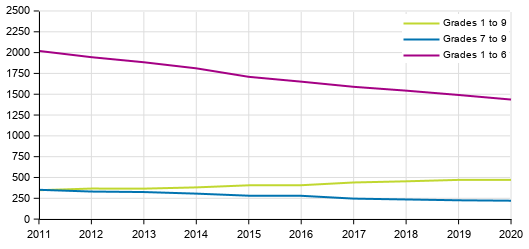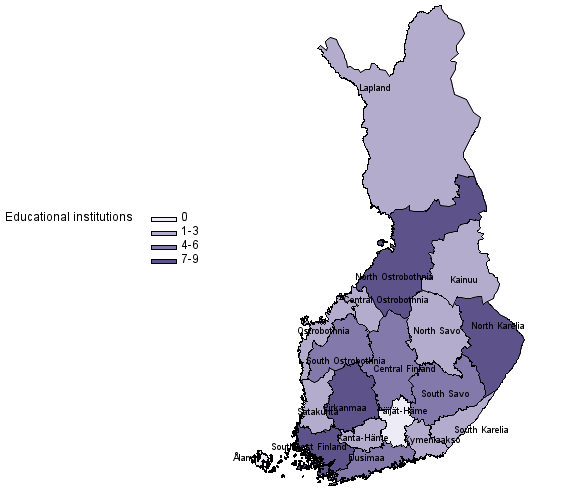Published: 18 February 2021
Number of comprehensive schools continued declining, most closures in North Ostrobothnia
According to Statistics Finland’s register of providers of education and register of educational institutions, there were 691 active providers of education and 3,105 educational institutions in which around 1.79 million students pursued studies at the end of 2020. There were 2,130 active comprehensive schools. Comprehensive schools were closed down most in North Ostrobothnia, in total eight.
Number of comprehensive schools 2011–2020

In 2020, there were 2,130 active comprehensive schools and they had a total of 548,100 pupils. Active special education schools at the comprehensive school level numbered 61 and they had 3,500 pupils. Comprehensive schools were more often than before joint schools comprising grades 1 to 9. In 2011, joint schools numbered 347, while the corresponding figure in 2020 was 471. In ten years, the share of joint schools in all comprehensive schools has grown by eight percentage points. In the corresponding time period, the share of primary schools has decreased by seven percentage points and that of lower secondary schools by three percentage points.
Number of closed down and merged comprehensive schools and special education schools at the comprehensive school level in 2020

A total of 64 comprehensive schools or comprehensive school level special education schools were closed down or merged with another educational institution. Twelve per cent of them were educational institutions with under 20 pupils, 50 per cent had between 20 and 49 pupils while 38 per cent had at least 50 pupils. Most comprehensive schools and special education schools at the comprehensive school level were closed down in North Ostrobothnia, eight in all. The next most closures and mergers were made in Pirkanmaa, North Karelia and Southwest Finland, seven in all of them.
Educational institutions of the school system and numbers of students by type of educational institution in 2020
| Type of educational institution | Number | Change from previous year 1) | Students 2) |
| 11 Comprehensive schools | 2 130 | -60 | 548 100 |
| 12 Comprehensive school level special education schools | 61 | -2 | 3 500 |
| 15 Upper secondary general schools | 335 | -1 | 114 300 |
| 19 Comprehensive and upper secondary general level schools | 40 | -1 | 28 300 |
| 21 Vocational institutes | 82 | -2 | 208 700 |
| 22 Special needs vocational institutes | 5 | - | 5 600 |
| 23 Specialised vocational institutes | 18 | -1 | 18 100 |
| 24 Vocational adult education centres | 10 | - | 15 000 |
| 28 Fire, police and security service institutes | 1 | - | 400 |
| 29 Military vocational institutes | 6 | - | .. |
| 41 Universities of applied sciences | 24 | -1 | 153 400 |
| 42 Universities | 13 | - | 160 400 |
| 43 Military academies | 1 | - | 900 |
| 61 Music schools and colleges | 83 | -1 | 59 200 |
| 62 Sports institutes | 13 | - | 13 100 |
| 63 Folk high schools | 72 | -1 | 16 000 |
| 64 Adult education centres | 174 | -4 | 405 100 |
| 65 Study circle centres | 12 | - | 11 800 |
| 66 Summer universities | 19 | - | 22 800 |
| 99 Other educational institutions | 6 | - | 400 |
| Total | 3 105 | -74 | 1 785 100 |
2) The data on the number of students are mainly as on 20 September 2020 and include the number of all students in educational institutions belonging to the type of educational institution independent of the level of education. Data on the number of students at comprehensive schools, universities, universities of applied sciences, vocational institutions and upper secondary institutions is preliminary.
In 2020, the number of providers of education was in total 13 lower than one year earlier. Of the providers of education, 49 per cent were municipalities or joint municipal authorities, four per cent were central government units and 45 per cent private. The remaining two per cent of the providers of education operated in the region of ┼land. In 2020, ten new providers of education were added to the Register of Providers of Education. The number of educational institutions was 74 lower than in the year before.
Source: Education Statistics. Statistics Finland
Inquiries: Mika Witting 029 551 3571, koulutustilastot@stat.fi
Head of Department in charge: Hannele Orjala
Publication in pdf-format (245.4 kB)
Updated 18.2.2020
Official Statistics of Finland (OSF):
Providers of education and educational institutions [e-publication].
ISSN=1799-5825. 2020. Helsinki: Statistics Finland [referred: 19.4.2024].
Access method: http://www.stat.fi/til/kjarj/2020/kjarj_2020_2021-02-18_tie_001_en.html

